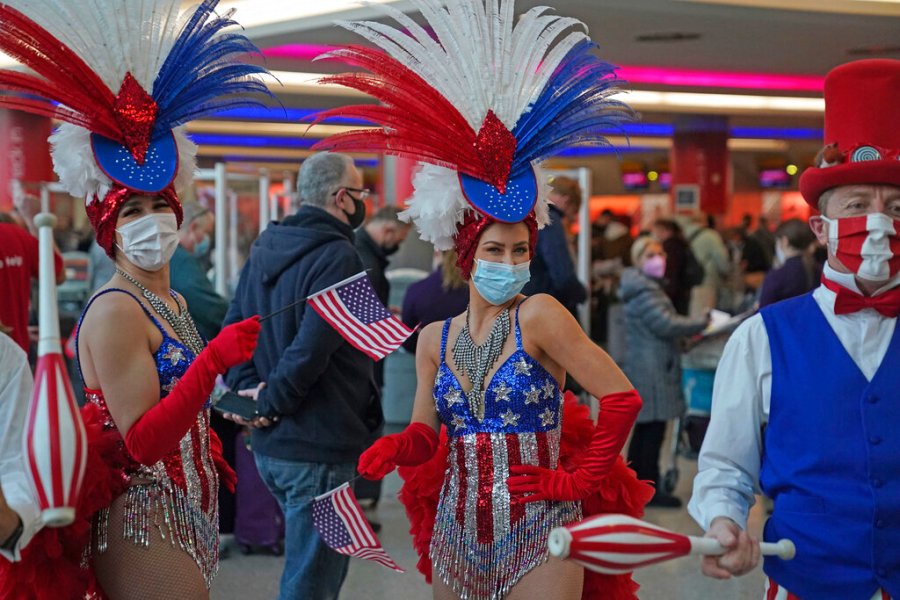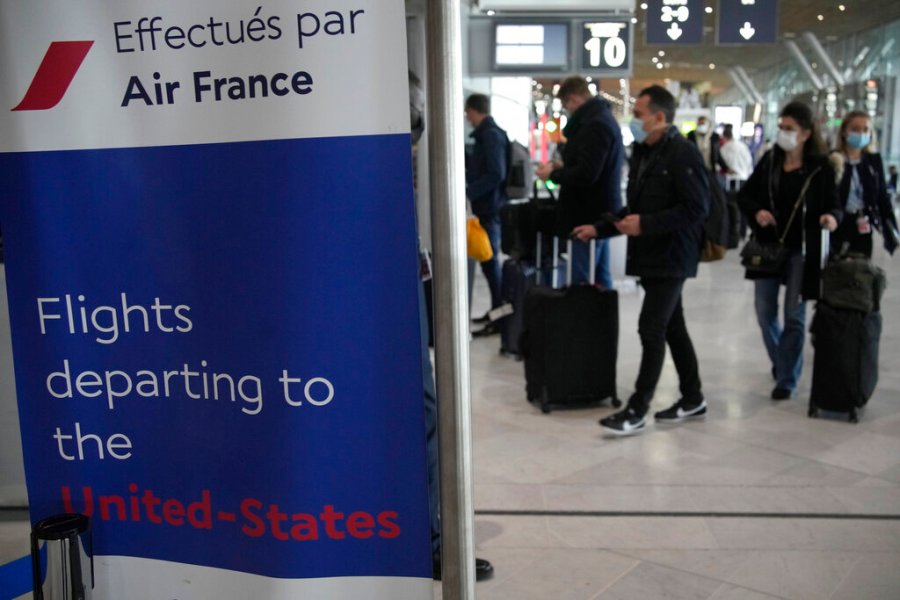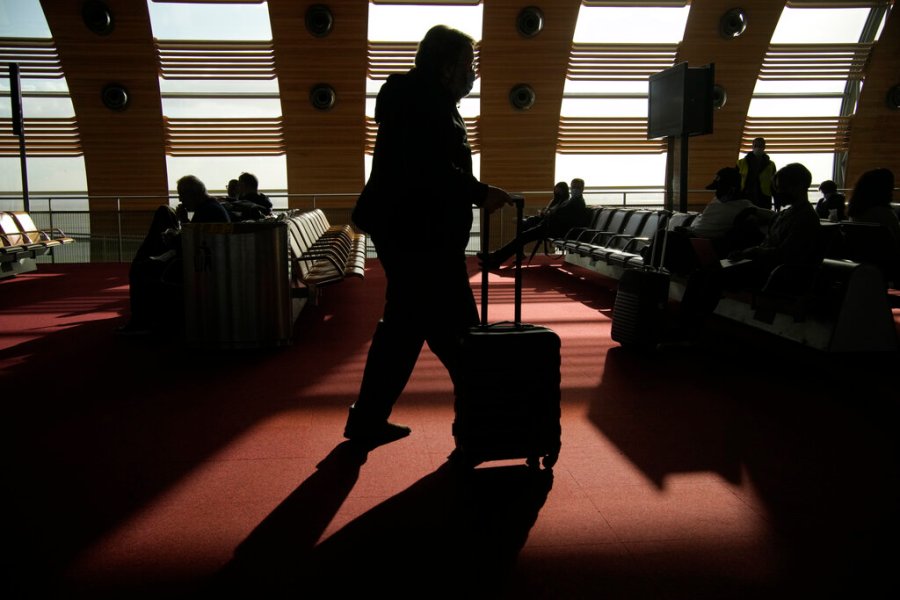Grandparents await hugs, spouses reunite as US borders open

Natalia Abrahao is lifted up by her fiancé Mark Ogertsehnig as they greet one another at Newark Liberty International Airport in Newark, N.J., Monday, Nov. 8, 2021. Pandemic travel restrictions have made their recent meetings difficult and infrequent. The U.S. lifted restrictions Monday on travel from a long list of countries including Mexico, Canada and most of Europe, setting the stage for emotional reunions nearly two years in the making and providing a boost for the airline and tourism industries decimated by the pandemic. (AP Photo/Seth Wenig)
SAN DIEGO (AP) — The U.S. fully reopened its borders with Mexico and Canada on Monday and lifted restrictions on travel that covered most of Europe, setting the stage for emotional reunions nearly two years in the making and providing a boost for the travel industry decimated by the pandemic.
The restrictions, among the most severe in U.S. history, kept families apart, including spouses who have not been able to hug in months, grandparents whose grandchildren doubled in age since they last saw them, and uncles and aunts who have not met nieces and nephews who are now toddlers.
Lines moved quickly Monday morning at San Diego’s border with Mexico, the busiest crossing in the United States, despite the added checks for vaccinations required to enter the country.
Octavio Alvarez, 43, zipped through in less than 15 minutes, coming to the United States for the first time since February 2020. Alvarez and his 14-year-old daughter, Sofia, planned to visit his mother-in-law in California for the first time in two years.
“It’s a big feeling,” said Alvarez, whose family visited California twice a month before the pandemic.
The emotional cost of the border restrictions were “very high,” he added.
The new rules also lift restrictions on air travel from some countries dating back to the early days of the pandemic — as long as travelers have proof of vaccination and a negative COVID-19 test.
American citizens and permanent residents were always allowed to enter the U.S., but the travel bans grounded tourists, thwarted business travelers and often separated families.
Gaye Camara, who lives in France, was already imagining her reunion Monday with her husband in New York. They last saw each other in January 2020, not knowing it would be 21 months before they could hold each other again.
“I’m going to jump into his arms, kiss him, touch him,” said Camara, 40, as she wheeled her luggage through Paris’ Charles de Gaulle Airport, where the humming crowds resembled those before the pandemic, except for the face masks.
On the U.S. borders with Mexico and Canada, where traveling back and forth was a way of life before the pandemic, the reopening brought relief.
Malls, restaurants and shops in U.S. border towns have been devastated by the lack of visitors from Mexico.
San Diego Mayor Todd Gloria, flanked by U.S. and Mexican officials at a celebratory news conference at the San Ysidro crossing, said the economic losses were hefty and the cutting of family ties “immeasurable.”
Tijuana Mayor Montserrat Caballero called it a “reunion between neighbor countries.”

Retail sales in San Ysidro on California’s border with Mexico fell about 75% from pre-COVID levels, forcing nearly 300 businesses to close.
“Wow, we can finally breathe!” Jason Wells, executive director of the San Ysidro Chamber of Commerce, said before dozens of cameras. “Please, put your cameras down and shop when you’re done.”
Along Canada’s boundary, cross-border hockey rivalries were upended. Churches that had members on both sides of the border were suddenly cut off from each other.
But Monday, border traffic quickly returned.
Travelers at the Peace Bridge in Buffalo, New York, one of the northern border’s busiest crossings, found a 2½-hour wait at 2 a.m., officials said, though within a few hours, traffic was flowing more freely. The bridge typically handles about 2 million passenger vehicles a year from Fort Erie, Ontario, many of them bound for the region’s shopping malls, ski slopes and sporting events. Volume dropped by more than 90% during the pandemic.
River Robinson’s American partner wasn’t able to be in Canada for the birth of their baby boy 17 months ago. She was thrilled to hear about the U.S. reopening and planned to take the child to the U.S. for Thanksgiving.
It’s “crazy to think he has a whole other side of the family he hasn’t even met yet,” said Robinson, who lives in St. Thomas, Ontario.
Airlines are preparing for a surge in activity — especially from Europe — after the pandemic and resulting restrictions caused international travel to plunge.
The 28 European countries that were barred under the U.S. policy that just ended made up 37% of overseas visitors in 2019, according to the U.S. Travel Association. As the reopening takes effect, carriers are increasing flights between the United Kingdom and the U.S. by 21% this month over last month, according to data from travel and analytics firm Cirium.
In a sign of the huge importance of trans-Atlantic travel for airlines, British Airways and Virgin Atlantic celebrated the reopening by synchronizing the departures of their early morning flights to New York on parallel runways at London’s Heathrow Airport. BA CEO Sean Doyle was aboard his company’s plane.
“Together, even as competitors, we have fought for the safe return of trans-Atlantic travel — and now we celebrate that achievement as a team. Some things are more important than one-upmanship, and this is one of those things,” Doyle wrote in a message to customers, noting that the flight carried the number that used to belong to the supersonic Concorde.
For Martine Kerherve, the long separation from loved ones in the United States was filled with worries that they might not survive the pandemic, which has killed more than 5 million people worldwide.
“We told ourselves that we could die without seeing each other,” said Kerherve, who was heading for Fort Lauderdale, Florida, from Paris. “We all went through periods of depression, anxiety.”
Maria Giribet has not seen her twin grandchildren, Gabriel and David, for about half of their lives. Now 3½, the boys are in San Francisco, which during the height of the pandemic might as well have been another planet for 74-year-old Giribet, who lives on the Mediterranean isle of Majorca.
“I’m going to hug them, suffocate them. That’s what I dream of,” said Giribet after checking in for her flight.
The U.S. will accept travelers who have been fully vaccinated with any of the shots approved for emergency use by the World Health Organization, not just those in use in the U.S. That’s a relief for many in Canada, where the AstraZeneca vaccine is widely used.
But millions of people around the world who were vaccinated with Russia’s Sputnik V, China’s CanSino or other shots not approved by the WHO will not be able to travel to the U.S.
Testing and quarantine requirements remained obstacles for others. A mobile testing truck was parked near the Peace Bridge in New York, promising results in 30 minutes for $225 and next-day results for $160.
Marcela Picone, 39, of the Buffalo suburb of Williamsville, has been waiting for the day her fiancé and father of their 2- and 3-year-old children can visit from Stoney Creek, Ontario. But his 15-year-old son would have to miss school to quarantine upon their return if they traveled.
The cost of testing was also a factor.
“I can’t expect my fiancé to spend $200 to come see his girls because we want to take them to a park or we want to do a birthday party in the states,” she said, adding: “He’s a dad to two American kids. He should have had the right to come into this country the entire 19 months.”
The moves come as the U.S. has seen its COVID-19 outlook improve dramatically in recent weeks since the summer delta surge that pushed hospitals to the brink in many locations.
Thompson reported from Buffalo, New York. Associated Press writers John Leicester at Paris’ Charles de Gaulle Airport, Travis Loller in Nashville, Tennessee, and Rob Gillies in Toronto contributed to this report.























